Kinesisk kapsel vender tilbage til Jorden med månesten
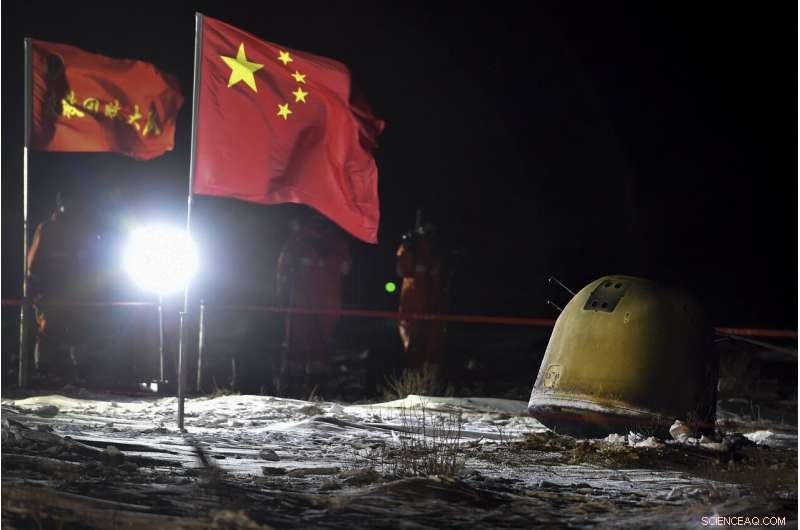
På dette foto udgivet af Xinhua News Agency, genopretningsbesætningsmedlemmer filmer kapslen fra Chang'e 5-sonden, efter dens succesrige landede i Siziwang-distriktet, nordlige Kinas autonome region Indre Mongoliet torsdag, 17. december, 2020. En kinesisk månekapsel vendte tilbage til Jorden torsdag med de første friske prøver af sten og affald fra månen i mere end 40 år. (Ren Junchuan/Xinhua via AP)
En kinesisk månekapsel vendte tilbage til Jorden torsdag med de første friske stenprøver fra månen i mere end 40 år, giver mulighed for ny indsigt i solsystemets historie og markerer et nyt vartegn for Kinas hastigt fremadskridende rumprogram.
Kapslen fra Chang'e 5-sonden landede lige før kl. 02.00 (1800 GMT onsdag) i Siziwang-distriktet i Indre Mongoliet-regionen, Det rapporterede China National Space Administration.
Kapslen var tidligere adskilt fra sit orbiter-modul og udførte et hop fra Jordens atmosfære for at reducere dens hastighed, før den passerede igennem og svævede til jorden i faldskærme. Efter bedring, kapslen og dens ladning af prøver blev fløjet til rumprogrammets campus i Beijing for at begynde processen med adskillelse og analyse, sagde rumadministrationen.
Missionen opnåede nye førstepladser for måneudforskningsprogrammet i indsamling af prøver, affyring af et køretøj fra månens overflade og forankre det med kapslen for at returnere prøverne til Jorden, sagde administrationen.
"Som vores nations mest komplekse og teknisk banebrydende rummission, Chang'e 5 har opnået adskillige tekniske gennembrud ... og repræsenterer en skelsættende præstation, " den sagde.
To af Chang'e 5's fire moduler satte sig ned på månen den 1. december og indsamlede omkring 2 kilo (4,4 pund) prøver ved at øse dem fra overfladen og bore 2 meter (ca. 6 fod) ind i måneskorpen. Prøverne blev deponeret i en forseglet beholder, der blev båret tilbage til returmodulet af et opstigningskøretøj.
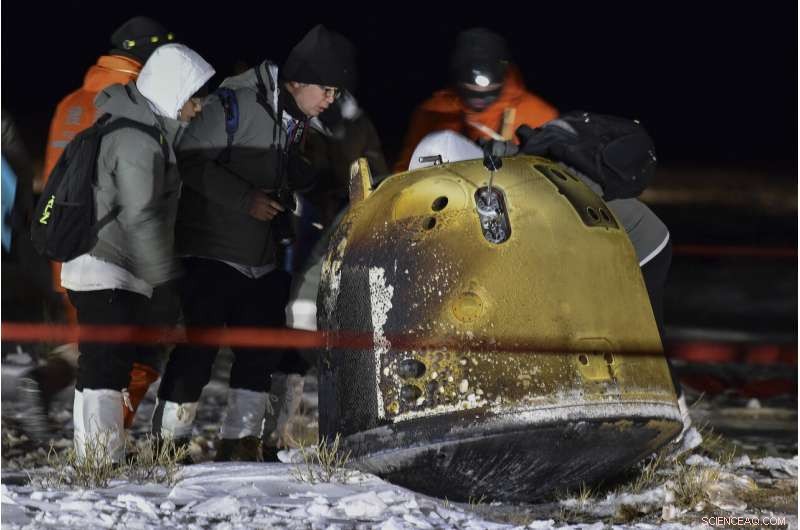
På dette foto udgivet af Xinhua News Agency, genopretningsbesætningsmedlemmer tjekker kapslen på Chang'e 5-sonden efter dens succesfulde landing i Siziwang-distriktet, nordlige Kinas autonome region Indre Mongoliet torsdag, 17. december, 2020. En kinesisk månekapsel vendte tilbage til Jorden torsdag med de første friske prøver af sten og affald fra månen i mere end 40 år. (Ren Junchuan/Xinhua via AP)
Til stor morskab for seerne, optagelser drevet af det statslige tv-selskab CCTV viste et lodnet hvidt dyr, muligvis en ræv eller gnaver, løb foran kapslen, mens den lå på jorden, stopper kort som for at spørge ind til den ukendte genstand.
Kinas leder Xi Jinping, i en erklæring læst op på Beijing Aerospace Control Center, kaldte det en stor bedrift, der markerede et stort skridt fremad for Kinas rumindustri. Xi udtrykte håb om, at missionsdeltagere ville fortsætte med at bidrage til at opbygge Kina til en stor rummagt og national foryngelse, sagde det statslige nyhedsbureau Xinhua.
Bjærgningsmandskab havde forberedt helikoptere og terrængående køretøjer til at tage imod signaler udsendt af månens rumfartøj og lokalisere det i mørket, der indhyller det enorme snedækkede område i Kinas fjerne nord. længe brugt som landingssted for Kinas Shenzhou-bemandede rumskibe.
Rumfartøjets tilbagevenden markerede første gang, at forskere har opnået friske prøver af månesten siden det tidligere Sovjetunionens Luna 24-robotsonde i 1976.
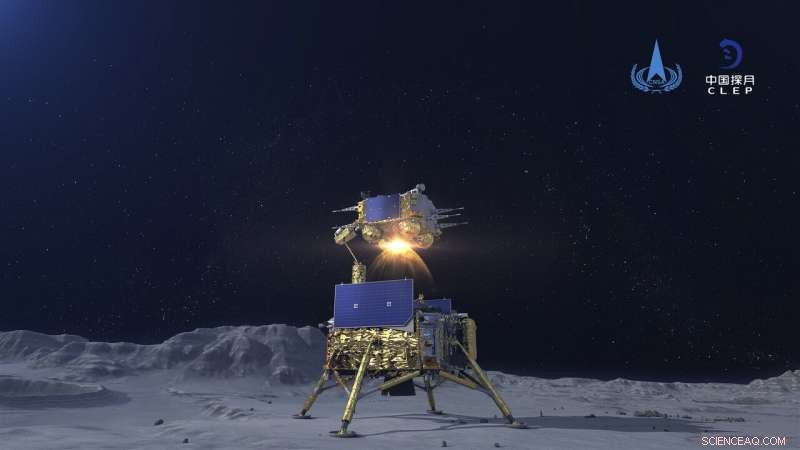
På dette billede fra Kinas nationale rumadministration (CNSA) udgivet af Xinhua News Agency, et simuleret billede af ascenderen af Chang'e-5-rumfartøjet, der sprænger af fra månens overflade ved Beijing Aerospace Control Center (BACC) i Beijing den 3. december, 2020. Den kinesiske månesonde løftede sig fra månen torsdag aften med en last af måneprøver på den første fase af dens tilbagevenden til Jorden, rapporterede statslige medier. (China National Space Administration/Xinhua via AP)
De nyligt indsamlede sten menes at være milliarder af år yngre end dem, der tidligere blev opnået af USA og det tidligere Sovjetunionen, tilbyder ny indsigt i månens og andre legemers historie i solsystemet. They come from a part of the moon known as the Oceanus Procellarum, or Ocean of Storms, near a site called the Mons Rumker that was believed to have been volcanic in ancient times.
As with the 382 kilograms (842 pounds) of lunar samples brought back by U.S. astronauts from 1969 to 1972, they will be analyzed for age and composition and are expected to be shared with other countries.
The age of the samples will help fill in a gap in knowledge about the history of the moon between roughly 1 billion and three billion years ago, Brad Jolliff, director of the McDonnell Center for the Space Sciences at Washington University in the U.S. city of St. Louis, wrote in an email. They may also yield clues as to the availability of economically useful resources on the moon such as concentrated hydrogen and oxygen, Jolliff said.
"These samples will be a treasure trove!" Jolliff wrote. "My hat is off to our Chinese colleagues for pulling off a very difficult mission; the science that will flow from analysis of the returned samples will be a legacy that will last for many, many years, and hopefully will involve the international community of scientists."

På dette foto udgivet af Xinhua News Agency, recovery crews look at the capsule of the Chang'e 5 probe after its successful landing at the main landing site in Siziwang district, north China's Inner Mongolia Autonomous Region on Thursday, 17. december, 2020. A Chinese lunar capsule returned to Earth on Thursday with the first fresh samples of rock and debris from the moon in more than 40 years. (Peng Yuan/Xinhua via AP)
Chang'e 5 blasted off from a launch base in China's southern island province of Hainan on Nov. 24 and appeared to have completed its highly technically sophisticated mission without a hitch.
It marked China's third successful lunar landing but the only one to lift off again from the moon. Its predecessor, Chang'e 4, became the first probe to land on the moon's little-explored far side and continues to send back data on conditions that could affect a future extended stay by humans on the moon.
The moon has been a particular focus of the Chinese space program, which says it plans to land humans there and possibly construct a permanent base. No timeline or other details have been announced.
China also has joined the effort to explore Mars. I juli, it launched the Tianwen 1 probe, which was carrying a lander and a robot rover to search for water.
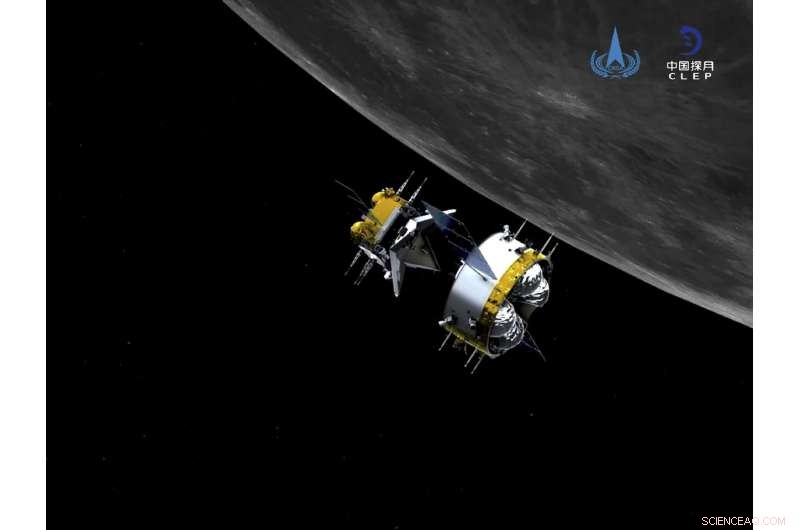
This graphic simulation image provided by China National Space Administration shows the orbiter and returner combination of China's Chang'e-5 probe after its separation from the ascender, at the Beijing Aerospace Control Center (BACC) in Beijing Sunday, Dec. 6, 2020. The Chinese probe that landed on the moon transferred rocks to an orbiter Sunday in preparation for returning samples of the lunar surface to Earth for the first time in almost 45 years, the country's space agency announced. (China National Space Administration/Xinhua via AP)
I 2003, China became the third country to send an astronaut into orbit on its own after the Soviet Union and the United States and its space program has proceeded more cautiously than the U.S.-Soviet space race of the 1960s, which was marked by fatalities and launch failures. By taking incremental steps, China appears on the path toward building a program that can sustain steady progress.
The latest flight includes collaboration with the European Space Agency, which is helping to monitor the mission. Amid concerns over the Chinese space program's secrecy and close military connections, the U.S. forbids cooperation between NASA and the CNSA unless Congress gives its approval. That has prevented China from taking part in the International Space Station, something it has sought to compensate for with the launching of an experimental space station and plans to complete a permanent orbiting outpost within the next two years.
© 2020 The Associated Press. Alle rettigheder forbeholdes. Dette materiale må ikke offentliggøres, udsende, omskrevet eller omfordelt uden tilladelse.
 Varme artikler
Varme artikler
-
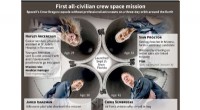 Glade SpaceX-turisthold bruger den første dag på at suse rundt på JordenGrafik på de fire helt civile passagerer på SpaceXs mission om at kredse om Jorden, lanceret den 15. september fra Florida. SpaceXs helt civile Inspiration4-besætning tilbragte deres første dag i
Glade SpaceX-turisthold bruger den første dag på at suse rundt på JordenGrafik på de fire helt civile passagerer på SpaceXs mission om at kredse om Jorden, lanceret den 15. september fra Florida. SpaceXs helt civile Inspiration4-besætning tilbragte deres første dag i -
 Fanget på fersk gerning:MeerKAT-teleskopet spionerer stjerneblusKredit:South African Radio Astronomy Observatory (SARAO) Forskere, der bruger MeerKAT-radioteleskopet, har opdaget en unik og hidtil uset opblussen af radioemission fra en binær stjerne i vores
Fanget på fersk gerning:MeerKAT-teleskopet spionerer stjerneblusKredit:South African Radio Astronomy Observatory (SARAO) Forskere, der bruger MeerKAT-radioteleskopet, har opdaget en unik og hidtil uset opblussen af radioemission fra en binær stjerne i vores -
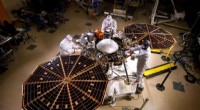 InSight styrer mod MarsSolpanelerne på NASAs InSight-lander er indsat i denne test i et rent rum hos Lockheed Martin Space Systems, Denver. Denne konfiguration er, hvordan rumfartøjet vil se ud på overfladen af Mars. Kred
InSight styrer mod MarsSolpanelerne på NASAs InSight-lander er indsat i denne test i et rent rum hos Lockheed Martin Space Systems, Denver. Denne konfiguration er, hvordan rumfartøjet vil se ud på overfladen af Mars. Kred -
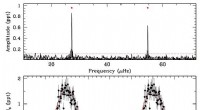 Pulseringer registreret i en varm, helium-atmosfære hvid dværgDet øverste panel viser lavfrekvente FT af PG 0112+104. Vi identificerer to væsentlige toppe, markeret med røde prikker, som beskriver fotometrisk modulering ved rotationsperioden og dens første harmo
Pulseringer registreret i en varm, helium-atmosfære hvid dværgDet øverste panel viser lavfrekvente FT af PG 0112+104. Vi identificerer to væsentlige toppe, markeret med røde prikker, som beskriver fotometrisk modulering ved rotationsperioden og dens første harmo


